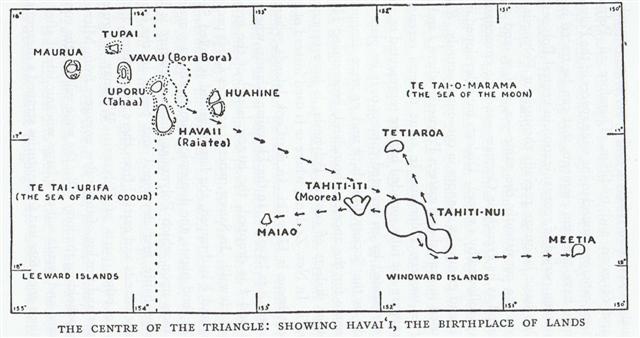Lamed (the Whip) was the last 'station' on Land, the 'threshing place'. Then came the Sea (Mem, water), the season for renewal and for fishing. ... The first half beginning with Alef - an ox, and ending with Lamed - a whip. The second list begins with Mem - water, and continues with Nun - fish, Samek - fish bones, Ayin - a water spring, Peh - the mouth of a well, Tsadi - to fish, Kof, Resh and Shin are the hook hole, hook head and hook teeth, known to exist from prehistoric times, and the Tav is the mark used to count the fish caught. When the Polynesians in their myths always kept alive the story of fishing up Land it probably was a reflection of the 2nd half in the sequence of stars (letters). "Tahiti did not always stand where it now is. Tahiti was transplanted here in the east from great Havai'i (Ra'iatea), hence the name Tâ-hiti (Transplanted). It came away as a huge fish, and then became land again; it resembled a ship with a great figurehead. It formed part of Havai'i, connecting it with Uporu (Taha'a). The sea was filled with it inland from Hiva (Clan) by Opoa (Indented) to the outer border of Uporu. All was one land, great Havai'i, that swept inwards and outwards." (Teuira Henry, Ancient Tahiti.)
The Phoenician station Nun (Fish) is close to the last part of the Babylonian Land, Nun-ki (also the name for σ Sagittarii). Water was central both for agriculture and for fishing. L-M-N as in elementa. According to the G text there was a great fish hook (Ga2-11) where σ Sagittarii was close to the Full Moon:
In January 3 (*288) Nunki was close to the Sun and in July 4 (185) Nunki was close to the Full Moon. It could have meant a new Land was about to be fished up from the deeps, a new Land also meaning a new Year. Ga2-11 (41) could be interpreted as 41 days after the March equinox. 80 + 41 = 121 (May 1). In rongorongo times Bharani rose with the Sun in RA day 41. The Chinese structure has the Winnowing Basket ('harvest') at day 354 (= 12 * 29½), whereas for the Hindus the date was December 24:
Notably the distance from May 1 (121) to December 24 (358) = 237 = 8 * 29½ + 1.
| |||||||||||||||||||||||||||||||||||||||||||||||||||||||||||||||||||||||||||||||||||||||||||||||||||||||||||||||||||||||||||||||||||||||||||||||||||


